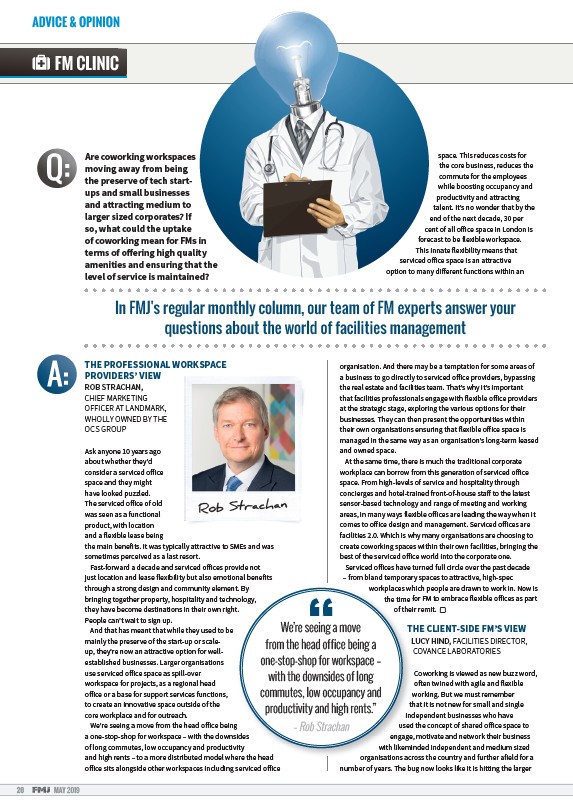
20 MAY 2019
In FMJ's regular monthly column, our team of FM experts answer your
questions about the world of facilities management
THE PROFESSIONAL WORKSPACE
PROVIDERS’ VIEW
ROB STRACHAN,
CHIEF MARKETING
OFFICER AT LANDMARK,
WHOLLY OWNED BY THE
OCS GROUP
Ask anyone 10 years ago
about whether they’d
consider a serviced o ice
space and they might
have looked puzzled.
The serviced o ice of old
was seen as a functional
product, with location
and a flexible lease being
the main benefits. It was typically attractive to SMEs and was
sometimes perceived as a last resort.
Fast-forward a decade and serviced o ices provide not
just location and lease flexibility but also emotional benefits
through a strong design and community element. By
bringing together property, hospitality and technology,
they have become destinations in their own right.
People can’t wait to sign up.
And that has meant that while they used to be
mainly the preserve of the start-up or scaleup,
they’re now an attractive option for wellestablished
businesses. Larger organisations
use serviced o ice space as spill-over
workspace for projects, as a regional head
o ice or a base for support services functions,
to create an innovative space outside of the
core workplace and for outreach.
We’re seeing a move from the head o ice being
a one-stop-shop for workspace – with the downsides
of long commutes, low occupancy and productivity
and high rents – to a more distributed model where the head
o ice sits alongside other workspaces including serviced o ice
space. This reduces costs for
the core business, reduces the
commute for the employees
while boosting occupancy and
productivity and attracting
talent. It’s no wonder that by the
end of the next decade, 30 per
cent of all o ice space in London is
forecast to be flexible workspace.
This innate flexibility means that
serviced o ice space is an attractive
option to many di erent functions within an
organisation. And there may be a temptation for some areas of
a business to go directly to serviced o ice providers, bypassing
the real estate and facilities team. That’s why it’s important
that facilities professionals engage with flexible o ice providers
at the strategic stage, exploring the various options for their
businesses. They can then present the opportunities within
their own organisations ensuring that flexible o ice space is
managed in the same way as an organisation’s long-term leased
and owned space.
At the same time, there is much the traditional corporate
workplace can borrow from this generation of serviced o ice
space. From high-levels of service and hospitality through
concierges and hotel-trained front-of-house sta to the latest
sensor-based technology and range of meeting and working
areas, in many ways flexible o ices are leading the way when it
comes to o ice design and management. Serviced o ices are
facilities 2.0. Which is why many organisations are choosing to
create coworking spaces within their own facilities, bringing the
best of the serviced o ice world into the corporate one.
Serviced o ices have turned full circle over the past decade
– from bland temporary spaces to attractive, high-spec
workplaces which people are drawn to work in. Now is
the time for FM to embrace flexible o ices as part
of their remit.
THE CLIENT-SIDE FM’S VIEW
LUCY HIND,
FACILITIES DIRECTOR,
COVANCE LABORATORIES
Coworking is viewed as new buzz word,
o en twined with agile and flexible
working. But we must remember
that it is not new for small and single
independent businesses who have
used the concept of shared o ice space to
engage, motivate and network their business
with likeminded independent and medium sized
organisations across the country and further afield for a
number of years. The bug now looks like it is hitting the larger
FM CLINIC
Are coworking workspaces
moving away from being
the preserve of tech startups
and small businesses
and attracting medium to
larger sized corporates? If
so, what could the uptake
of coworking mean for FMs in
terms of o ering high quality
amenities and ensuring that the
level of service is maintained?
Rob Strachan
ADVICE & OPINION
We’re seeing a move
from the head office being a
one-stop-shop for workspace –
with the downsides of long
commutes, low occupancy and
productivity and high rents.”
– Rob Strachan